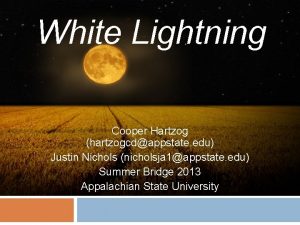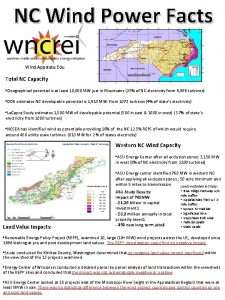NC Wind Power Facts Wind Appstate Edu Total


- Slides: 2

NC Wind Power Facts Wind. Appstate. Edu Total NC Capacity • Geographical potential is at least 10, 000 MW just in Mountains (25% of NC electricity from 6, 666 turbines) • DOE estimates NC developable potential is 1, 610 MW from 1073 turbines (4% of state’s electricity) • La. Capra Study estimates 1, 500 MW of developable potential (500 in east & 1000 in west) (3. 7% of state’s electricity from 1000 turbines) • NCSEA has identified wind as potentially providing 16% of the NC 12. 5% REPS of which would require around 450 utility scale turbines (810 MW for 2 % of states electricity) Western NC Wind Capacity • ASU Energy Center after all exclusion zones: 3, 150 MW in west (8% of NC electricity from 2100 turbines) • ASU Energy center identified 768 MW in western NC after applying all exclusion zones ; 50 acre minimum and within 5 miles to transmission Lands excluded In Study: Land Value Impacts: ASU Study Results: Impact of 768 MW ‐ $1. 26 billion in capital Investment 1 ‐ $8. 2 million annually in local property taxes 1 ‐ 350 new long term jobs 1 • Blue Ridge Parkway w/1 mile buffer • Appalachian Trail w / 1‐ mile buffer • Spruce Fir Habitat • Significant NHA • Important Bird Area • Federal Lands • State Lands • Renewable Energy Policy Project (REPP), examined 10, large (10+ MW) wind projects across the US, developed since 1998 looking at pre and post development land values. The REPP investigation could find no negative impact. • Study conducted for Kittitas County, Washington determined that no negative land value impact was found within the view shed of the 13 projects examined. • Energy Center of Wisconsin conducted a detailed parcel by parcel analysis of land transactions within the viewsheds of the REPP sites and concluded that the impact was not systematically negative or positive. • ASU Energy Center looked at 15 projects east of the Mississippi River (eight in the Appalachian Region) that were at least 5 MW in size. There was no statistical difference between the wind project counties and control counties on pre and post land values.

NC Wind Power Facts Wind. Appstate. Edu Coastal NC Wind Capacity • 1, 430 MW wind capacity on‐shore and in sound waters from 2 and 3 MW turbines over 26. 5 square miles. (off‐shore not considered) • Transmission bottlenecks heading west may be the largest restriction of capacity. • Upcoming study by UNC to give more detail to coastal opportunity. Economic Impacts: Each 100 MW of wind energy development in region will produce approximately: • $27 million in direct, indirect, & induced economic benefit to state during construction and $3 million each year during operation • $7. 32 million paid in wages during construction and $1. 35 million in wages each year during operation – 250 jobs during construction – 45 long term jobs • Property tax revenue: approximately $1, 000/year in NC • Land Lease Payments: $250, 000 ‐ $400, 000/year (2‐ 3% of gross revenue or $2500‐ 4000/MW/year) • Approximately 350 million kwh every year, at a competitive price and without any air pollution or energy price increases. Enough to power 33, 000 houses. • Each MW of wind development costs approximately $1 million dollars • Each MW of wind will produce between 3 – 3. 5 million kwh/year on a good wind site. 1. Assump: ons based on NREL Economic Benefits of 1, 000 MW of Wind Energy in NC publica: on. Available at: h. Vp: //www. windpoweringamerica. gov/pdfs/economic_development/2009/nc_wind_benefits_factsheet. pdf



